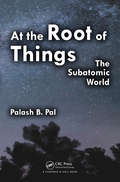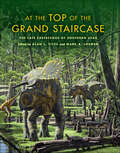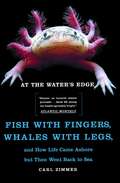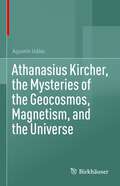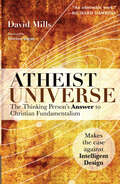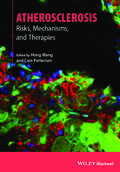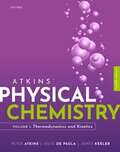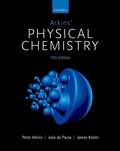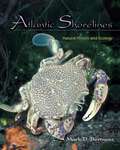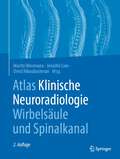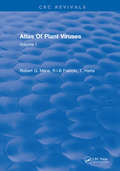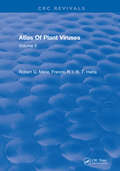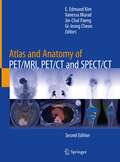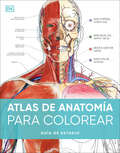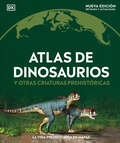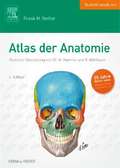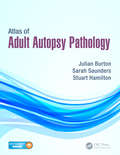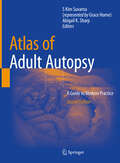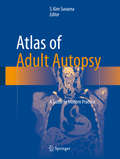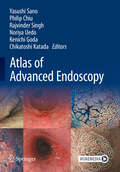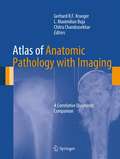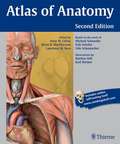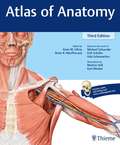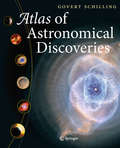- Table View
- List View
At the Root of Things: The Subatomic World
by Palash Baran PalAt the Root of Things: The Subatomic World is a journey into the world of elementary particles-the basic constituents of all matter in the universe-and the nature of the interactions among them. The book begins with a summary of pre-quantum physics and later tackles quantum physics, which is essential for the study of elementary particles. It is written in a non-technical way so that anyone interested about these issues will be able to read it. All and all, this is a book that not only helps outsiders understand the subject in a non-mathematical manner; it also inspires them to join the exciting endeavor. It contains many line diagrams to illustrate the ideas and a few mathematical equations like E = mc2.
At the Top of the Grand Staircase: The Late Cretaceous of Southern Utah (Life of the Past)
by Alan L. Titus and Mark A. LoewenThe Grand Staircase-Escalante National Monument is the location of one of the best-known terrestrial records for the late Cretaceous. Prior fieldwork confirmed the richness of the area, but a major effort begun in the new century has documented over 2,000 new vertebrate fossil sites, provided new radiometric dates, and identified five new genera of ceratopsids, two new species of hadrosaur, a probable new genus of hypsilophodontid, new pachycephalosaurs and ankylosaurs, several kinds of theropods (including a new genus of oviraptor and a new tyrannosaur), plus the most complete specimen of a Late Cretaceous therizinosaur ever collected from North America, and much more. The research documented in this book is rewriting our understanding of Late Cretaceous paleobiogeography and dinosaur phyletics. At the Top of the Grand Staircase: The Late Cretaceous of Southern Utah is a major stepping stone toward a total synthesis of the ecology and evolution of the Late Cretaceous ecosystems of western North America.
At the Water's Edge: Fish with Fingers, Whales with Legs, and How Life Came Ashore but Then Went Back to Sea
by Carl ZimmerEverybody Out of the Pond At the Water's Edge will change the way you think about your place in the world. The awesome journey of life's transformation from the first microbes 4 billion years ago to Homo sapiens today is an epic that we are only now beginning to grasp. Magnificent and bizarre, it is the story of how we got here, what we left behind, and what we brought with us. We all know about evolution, but it still seems absurd that our ancestors were fish. Darwin's idea of natural selection was the key to solving generation-to-generation evolution -- microevolution -- but it could only point us toward a complete explanation, still to come, of the engines of macroevolution, the transformation of body shapes across millions of years. Now, drawing on the latest fossil discoveries and breakthrough scientific analysis, Carl Zimmer reveals how macroevolution works. Escorting us along the trail of discovery up to the current dramatic research in paleontology, ecology, genetics, and embryology, Zimmer shows how scientists today are unveiling the secrets of life that biologists struggled with two centuries ago. In this book, you will find a dazzling, brash literary talent and a rigorous scientific sensibility gracefully brought together. Carl Zimmer provides a comprehensive, lucid, and authoritative answer to the mystery of how nature actually made itself.
Athanasius Kircher, the Mysteries of the Geocosmos, Magnetism, and the Universe
by Agustín UdíasAthanasius Kircher, the eminent 17th-century German Jesuit professor of mathematics at the Roman College emerges as a captivating figure within the pages of this monograph by Agustín Udías. Aptly deemed 'the man who knew everything,' Kircher's thirty-two comprehensive works, spanning an array of subjects, provide a unique lens into his visionary perspectives. This book delves into three selected works where Kircher unveils his conceptualization of the Earth, termed the 'Geocosmos,' treated magnetism as a cosmic and spiritual force, and embarks on a cosmic exploration from Earth to the stars. From his groundbreaking speculations on the Earth's interior, attributing earthquakes and volcanoes to intricate channels of air, water, and fire, to his cosmic journey accompanied by the ethereal spirit Cosmiel, Kircher's enduring allure persists. Despite variance from contemporary knowledge, situated at the beginning of modern science, Kircher's proposals of the structure of the Earth’s interior, cosmic magnetic theories, and space journey to the stars offer a compelling glimpse into the intellectual landscape of a bygone era, making this book an essential exploration for scholars seeking a nuanced understanding of Kircher's profound influence.
Atheist Universe: The Thinking Person's Answer to Christian Fundamentalism
by David MillsUsing logic, common sense, philosophy, ethics, history, and science, the author rebuts every argument that claims to “prove” the existence of God.IS THERE REALLY A GOD?OR DOES GOD EXIST ONLY IN OUR HEADS?IS THE BIBLE TRULY GOD’S WORD?OR IS IT A JUMBLE OF FANCIFUL MYTHS?Atheist Universe details why God is unnecessary to explain the universe’s diversity, organization and beauty. Using simple, straightforward logic, this book rebuts every argument that claims to “prove” God’s existence.A comprehensive primer for countering today’s religious dogma, Atheist Universe addresses all the historical and scientific questions, including:•What is atheism, and why is it so misunderstood?•If God is a myth, then how did the universe appear?•Without God, is there an objective “right” and “wrong”?•What is the meaning of life without God?•Is there evidence of Jesus’s miracles and resurrection?•Can atheists explain “near death” experiences and medical miracles?•Can science and the Bible realistically be reconciled?•What is the behind-the-scenes relationship between politics and religion?“An admirable work.” —Richard Dawkins“David’s work will be very useful for anyone combating harmful religious beliefs. Honest, frank, and right to the point!”—Albert Ellis, Ph.D., father of modern psychotherapy, author of A Guide to Rational Living
Atherosclerosis
by Cam Patterson Hong WangComprehensive and in-depth in its coverage, Atherosclerosis: Cellular, Molecular & Biochemical Mechanism and Novel Therapy reviews the recent progress in atherosclerosis research and offers cutting edge perspectives from experts in the field. Written by an international team of authors including leading physician-scientists, research experts and physicians, chapters are divided into four major sections, covering risk factors, cellular and molecular mechanisms, biochemical mechanisms and novel and future therapeutics. Atherosclerosis: Cellular, Molecular & Biochemical Mechanism and Novel Therapy analyses recent progress from both conceptual and technological perspectives, suggesting new directions for atherosclerosis research and treatment for a growing population of researchers and clinicians in cardiovascular and related fields.
Atherosclerosis: Methods and Protocols (Methods in Molecular Biology #2419)
by Dipak P. RamjiThis volume provides detailed, up-to-date methods used in research on Atherosclerosis. Chapters guide readers through an overview of the pathogenesis of atherosclerosis and model systems together with in vitro, ex vivo, in vivo and emerging methods in atherosclerosis research. Written in the highly successful Methods in Molecular Biology series format, chapters include introductions to their respective topics, lists of the necessary materials and reagents, step-by-step, readily reproducible laboratory protocols, and tips on troubleshooting and avoiding known pitfalls. Authoritative and cutting-edge, Atherosclerosis: Methods and Protocols serves as an invaluable resource for those engaging in research on atherosclerosis and cardiovascular disease, as well as for researchers who are new to the field and students at both the undergraduate and postgraduate level.
Atkins Physical Chemistry V1
by Peter Atkins Julio De Paula And James KeelerAtkins' Physical Chemistry is widely acknowledged by students and lecturers around the globe to be the textbook of choice for studying physical chemistry. The exceptional quality of previous editions has been built upon to make the twelfth edition of Atkins' Physical Chemistry even more closely suited to the needs of both lecturers and students. The writing style has been refreshed in collaboration with current students of physical chemistry in order to retain the clarity for which the book is recognized while mirroring the way that students read and engage with information. The new edition is now available as an enhanced e-Book, which offers a richer, more dynamic learning experience. It does this by incorporating digital enhancements that are carefully curated and thoughtfully inserted at meaningful points to enhance the learning experience. In addition, it offers formative auto-graded assessment materials to provide students with regular opportunities to test their understanding. Digital enhancements introduced for the new edition include dynamic graphs, which students can interact with to explore how the manipulation of variables affects the results of the graphs; self-check questions at the end of every "Topic"; video content from physical chemists; and video tutorials that accompany the "Focus" features, which dig deeper into the key equations introduced. There is also a new foundational prologue entitled "Energy: A First Look," which summarizes key concepts that are best kept in mind right from the beginning of physical chemistry studies. The coupling of the broad coverage of the subject with a structure and use of pedagogy that is even more innovative will ensure that Atkins' Physical Chemistry remains the textbook of choice for studying physical chemistry.
Atkins' Physical Chemistry
by James Keeler Peter Atkins Julio PaulaAtkins' Physical Chemistry is widely acknowledged by both students and instructors around the globe to be the textbook of choice for studying physical chemistry. The eleventh edition has been enhanced with additional learning features and math support, and reorganized into discrete Topics, to make the text more flexible for teachers and more readable for students. WebAssign New for this edition, Atkins' Physical Chemistry can be packaged with WebAssign, a flexible and fully customizable online instructional solution. It allows instructors to deploy assignments and to instantly assess individual student performance. For packaging information, or to arrange a demo, contact your OUP sales representative.
Atlantic Shorelines: Natural History and Ecology
by Mark D. BertnessA comprehensive introduction to the natural history and intertidal ecology of East Coast shorelinesAtlantic Shorelines is an introduction to the natural history and ecology of shoreline communities on the East Coast of North America. Writing for a broad audience, Mark Bertness examines how distinctive communities of plants and animals are generated on rocky shores and in salt marshes, mangroves, and soft sediment beaches on Atlantic shorelines.The book provides a comprehensive background for understanding the basic principles of intertidal ecology and the unique conditions faced by intertidal organisms. It describes the history of the Atlantic Coast, tides, and near-shore oceanographic processes that influence shoreline organisms; explains primary production in shoreline systems, intertidal food webs, and the way intertidal organisms survive; sets out the unusual reproductive challenges of living in an intertidal habitat, and the role of recruitment in shaping intertidal communities; and outlines how biological processes like competition, predation, facilitation, and ecosystem engineering generate the spatial structure of intertidal communities.The last part of the book focuses on the ecology of the three main shoreline habitats—rocky shores, soft sediment beaches, and shorelines vegetated with salt marsh plants and mangroves—and discusses in detail conservation issues associated with each of them.
Atlas Klinische Neuroradiologie Wirbelsäule und Spinalkanal
by Jennifer Linn Martin Wiesmann Omid NikoubashmanSicher Befunden in der Neuroradiologie!Die zweite Auflage des beliebten Atlas gibt zunächst im großen Anatomiekapitel eine hervorragende Übersicht zur klinischen Anatomie der Wirbelsäule und des Rückenmarks, mit vielen exzellenten, neu angefertigten Zeichnungen. Die nachfolgenden Kapitel beschreiben detailliert und mit über 1.000 Abbildungen sowohl gängige als auch seltene Pathologien. Mit den Neuerungen und Überarbeitungen der 2. Auflage ist es das bei weitem umfassendste und detaillierteste Werk zur Neuroradiologie der Wirbelsäule und des Rückenmarks.Neu in der zweiten Auflage:Über 400 Abbildungen wurden in der 2. Auflage erneuert oder neu bearbeitet. Außerdem wurden 40 neue Krankheitsbilder hinzugefügt wie z.B. verschiedene Motoneuronerkrankungen wie Muskelatrophien, ALS etc., bei metabolischen Erkrankungen wie Amyloidose, vertebrale Gicht etc. oder Tumorerkrankungen wie:Benigner notochordaler Tumor (BNCT), Leukämie, Lymphom, Mastozytose, Myelofibrose.Krankheitsbilder aus allen Bereichen:Tumoren und Zysten Verletzungen, Entzündungen und FehlbildungenDegenerative, vaskuläre und metabolische ErkrankungenAn die Bedürfnisse des befundenden Arztes angepasst: detaillierte Beschreibung der Morphologie anhand verschiedener Modalitäten und Sequenzen;hervorragende Bildqualität der Referenzabbildungen;moderne Schnittbilddiagnostik und konventionelles Röntgen;stichwortartiger Text zur schnellen Informationsaufnahme;ausführliche Berücksichtigung der Differenzialdiagnosen.Zum schnellen Nachschlagen aber auch zum vertiefenden Nachlesen geeignet, ideal auch zur Vorbereitung auf die Facharzt- und Schwerpunktprüfung.Die ideale Ergänzung zum ersten Band "Atlas Klinische Neuroradiologie des Gehirns" bildet der „Atlas Klinische Neuroradiologie - Wirbelsäule und Spinalkanal“.
Atlas Of Plant Viruses: Volume I
by Robert G. Francki R.I.B; MilneThis book assembles a comprehensive collection of plant virus electron micrographs of good quality, offers a consistent treatment, and backs the visual data with a consistent and comprehensive text. Although this book is primarily about the structure of virus particles and infected cells, the results of biochemical experiments are referred too when relevant, so that the virus particles described appear as part of a replicating complex. Similarly, infected cells are portrayed as active rather than static structures.
Atlas Of Plant Viruses: Volume II
by Robert G. Francki R.I.B; MilneThis book assembles a comprehensive collection of plant virus electron micrographs of good quality, offers a consistent treatment, and backs the visual data with a consistent and comprehensive text. Although this book is primarily about the structure of virus particles and infected cells, the results of biochemical experiments are referred too when relevant, so that the virus particles described appear as part of a replicating complex. Similarly, infected cells are portrayed as active rather than static structures.
Atlas and Anatomy of PET/MRI, PET/CT and SPECT/CT
by E. Edmund Kim Vanessa Murad Jin-Chul Paeng Gi-Jeong CheonThis atlas showcases cross-sectional anatomy for the proper interpretation of images generated from PET/MRI, PET/CT, and SPECT/CT applications. Hybrid imaging is at the forefront of nuclear and molecular imaging and enhances data acquisition for the purposes of diagnosis and treatment. Simultaneous evaluation of anatomic and metabolic information about normal and abnormal processes addresses complex clinical questions and raises the level of confidence of the scan interpretation. Extensively illustrated with high-resolution PET/MRI, PET/CT and SPECT/CT images, this atlas provides precise morphologic information for the whole body as well as for specific regions such as the head and neck, abdomen, and musculoskeletal system. Atlas and Anatomy of PET/MRI, PET/CT, AND SPECT/CT, Second Edition is a unique resource for physicians and residents in nuclear medicine, radiology, oncology, neurology, and cardiology.
Atlas de anatomía para colorear (The Human Body Coloring Book): Guía de estudio
by DKEl recurso perfecto para que los estudiantes y expertos en medicina amplíen sus conocimientos de anatomía.Este libro de anatomía para colorear te ayuda a estudiar de una forma diferente, relajante y divertida. Aprende y memoriza con facilidad toda la información sobre la anatomía humana mientras desconectas y potencias tu creatividad con más de 200 dibujos en blanco y negro repletos de detalles para colorear. Con información de las diferentes partes del cuerpo humano y sus funciones.Incluye todos los tejidos, órganos, aparatos y estructuras del cuerpo, desde las minúsculas células hasta los sistemas más complejosCada página contiene una leyenda que te indica qué parte del cuerpo humano colorear y con qué número se corresponde. ¡No las mires si quieres ejercitar tu memoria! Puedes usarlas para comprobar si tus respuestas son correctas.¡Ponle nombre a cada una de las partes del cuerpo humano, coloréalas y aprende todo el vocabulario anatómico en español que necesitas para superar tus exámenes con éxito!Y si quieres seguir aprendiendo, complementa tus estudios de anatomía con El gran libro del cuerpo humano, la guía definitiva para conocer el funcionamiento del cuerpo a fondo, a través de ilustraciones en 3D e imagenología médica.Studying the human body is easy with this interactive biology colouring book! Color and label anatomical diagrams to learn and recall everything there’s to know about the human body. This drawing book helps you understand human anatomy while giving you the opportunity to learn, understand and remember information with ease! This biology study guide is a wonderful way to learn about the parts and systems of the human body! Inside, you’ll find:More than 200 highly detailed anatomical drawings to colorCrystal clear instructions that explain exactly what is required of each artworkComprehensive coverage of the human body and from cell to systemDiscover the human body by naming each part and coloring it! Filled with black and white line artwork, this anatomy coloring book helps you study anatomical illustrations in an interactive and fun way. The biology coloring guide gives clear instructions on what needs to be colored and which colors to use. Then you are left to color and label the parts and systems of the body while improving your knowledge of human anatomy.
Atlas de dinosaurios (DK Where on Earth? Atlases)
by DKViaja a través del tiempo para descubrir dónde vivían los dinosaurios y cómo era nuestro planeta en el pasado. Esta enciclopedia para niños de más de 9 años te invita a explorar el mundo de los dinosaurios, de los reptiles marinos y de otras muchas criaturas que habitaron la Tierra hace millones de años. A través de impresionantes imágenes generadas por computadora, da vida a cada una de estas especies y ofrece descripciones detalladas de su aspecto físico y de los lugares que habitaron. Además, incluye muchos datos y diagramas basados en los últimos descubrimientos científicos que lo convierten en el regalo perfecto para los más curiosos. Pasa las páginas de este increíble atlas de dinosaurios y encuentra:-Descripciones y explicaciones sobre más de 40 criaturas de la prehistoria, acompañadas de impactantes imágenes en 3D y contextualizadas en el período en que existieron: Triásico, Jurásico, Cretácico...-Mapas que muestran la Tierra primitiva y dónde se ubicaría cada continente en la actualidad.-Cada capítulo se centra en un continente y los dinosaurios que lo habitaron.-Recreaciones digitales de escenarios de la vida cotidiana de los diferentes dinosaurios y animales prehistóricos.¡Enfréntate a un tiranosaurio en Norteamérica, escóndete de las garras de los velociraptors en el desierto de Gobi o atraviesa la tundra de Siberia para ver a un mamut! Observa el mundo prehistórico desde una perspectiva nueva y distinta con Atlas de dinosaurios y otras criaturas prehistóricas, un libro ilustrado imprescindible en la colección de los pequeños expertos en paleontología. Journey back in time and discover where dinosaurs roamed in this special children’s atlas, exploring each continent.Stare down a T-Rex in North America. Watch out for Velociraptors’ slashing claws in the Gobi Desert. Trek across the Siberian tundra and discover a woolly mammoth. This innovative book uses impressive computer-generated imagery to make every dinosaur come to life. This fascinating dinosaur book for kids has maps of early Earth and more than 40 profiles of dinosaurs and other prehistoric animals. Children aged 9+ can explore the world of dinosaurs and other prehistoric creatures through brand-new maps and incredible artworks based on the latest scientific research, revealing fossils and stories on every map!This dinosaur atlas for children offers: -A breakdown of each continent by chapter, showing where dinosaurs and other prehistoric animals appeared at a given time.-A connection of each dinosaur to a period – Triassic, Jurassic, or Cretaceous.-Specially commissioned maps and 3D locator globes link the prehistoric world to the present day.-Vivid double-page features show dinosaurs and other prehistoric animals in dynamic scenes.Dinosaur Atlas reveals the prehistoric world in a fresh, new atlas approach and is an essential addition to the library of every young dinosaur expert.
Atlas der Anatomie, German Edition
by Frank H. NetterNetter's Atlas der Anatomie beweist seit 25 Jahren, dass Anatomie lernen auch locker sein kann. Die preisgekrönten Darstellungen im typischen Netter-Stil führen von vereinfachten Darstellungen zu komplexen Strukturen. Detailreich beschriftet und von bestechender Klarheit und Präzision – so wird Anatomie greifbar! In deutscher Sprache mit deutsch-englischen Legenden mit je einem deutschen und einem englischen Sachregister. Die Abbildungen sind mit lateinischer Nomenklatur beschriftet. <P><P> <ul> <li>Praktisch: Die gesamte Anatomie in einem Band - ideal zum Mitnehmen in den Präpkurs</li> <li>Typisch Netter: Die Abbildungen treffen genau die Mischung aus realistischer Darstellung und didaktisch einprägsamer Schemazeichnung</li> <li>Umfangreich: Über 2.000 aussagekräftige Abbildungen – viele Bildthemen sind über unterschiedliche Beschriftungen optimal verständlich dargestellt</li> <li>Für die aktuelle AO: Zahlreiche klinische Bilder und Röntgenbilder</li> </ul> <P><P> Neu in der 6. Auflage: Noch stärkerer klinischer Fokus, Tabellen zu Funktion, Ansatz, Ursprung und Innervation von Muskeln
Atlas of Adult Autopsy Pathology
by Stuart Hamilton Julian Burton Sarah SaundersThe Atlas of Adult Autopsy Pathology is a full-color atlas for those performing, or learning to perform, adult autopsies. It is arranged by organ systems and also includes chapters on external examination findings, the effect of decomposition, and histopathological findings, as well as procedures and devices one may encounter during autopsy.The boo
Atlas of Adult Autopsy: A Guide to Modern Practice
by S. Kim Suvarna Abigail K. SharpThis new second edition of the successful 2016 Atlas of Adult Autopsy Practice is fully updated and refreshed with novel illustrations, and data refinements. It leads with pictures, focused text, and commentary on the autopsy itself as a specialist pathology subject. The content expands the coverage of specialist techniques with chapters covering post-mortem imaging, toxicology, neuropathology and forensic pathology from practising specialists. The addition of an original chapter addressing post-mortem histology adeptly contributes to the autopsy training literature. The book – a mainstay for the numerous practitioners working in this field, provides a standard for autopsy practice in the UK, Europe and beyond.
Atlas of Adult Autopsy: A Guide to Modern Practice
by S. Kim SuvarnaThisatlas leads the reader through the adult autopsy process, and its commonvariations, with a large number of high-quality macroscopic photographs andconcise accompanying text. It provides a manual of current practice and is aneasy-to-use resource for case examination for consent, medico-legal andradiological autopsies. Externalrealities and checks are discussed at the beginning of the book, which goes onto cover specific body cavities and organ systems in detail. The book ends withchapters on topics including forensic autopsies, specialist sampling, toxicologyanalyses and the radiological autopsy. Atlasof Adult Autopsy is aimed at practicing pathologists, particularly those intraining grades. It may also be of interest to anatomical technicians inautopsy suites, as well as parties with a legal interest in autopsy practice.
Atlas of Advanced Endoscopy
by Yasushi Sano Noriya Uedo Rajvinder Singh Philip Chiu Kenichi Goda Chikatoshi KatadaThis comprehensive book features high-quality images, videos, and step-by-step instructions for capturing detailed views of the upper and lower gastrointestinal tract from the oral cavity to the anus. In addition to covering areas such as the tongue, head and neck, non-Barrett's esophagus, Barrett's esophagus, stomach, duodenum, colon, and rectum, the atlas is authored by leading GI experts from the Asian Novel Bio-Imaging and Intervention Group in the Asia-Pacific region, known for their unparalleled expertise and commitment to excellence. The book covers various aspects, including equipment reviews and diagnostic technologies using the latest unified global standard system. It explains techniques such as high-definition endoscopy, magnifying endoscopy, chromoendoscopy, NBI, TXI, RDI, and AI, while also providing insight into classifications such as the Japan Esophageal Society Classification, the VS Classification/MESDA-G, and the JNET Classification. Each case section provides expert analysis and notable endoscopic images, accompanied by histopathologic images depicting various benign lesions and early cancers. The Atlas of Advanced Endoscopy serves as an invaluable resource to enhance the reader's knowledge and understanding of the complexities of gastrointestinal endoscopy. It is designed to help practitioners, clinicians, gastroenterologists, and medical students learn diagnostic strategies, procedures, and clinically significant cases. We hope this atlas will always be at your side in the endoscopy room.
Atlas of Anatomic Pathology with Imaging: A Correlative Diagnostic Companion
by Gerhard R Krueger L Maximilian Buja Chitra ChandrasekharAtlas of Anatomic Pathology with Imaging - A Correlative Diagnostic Companion is a valuable teaching tool for medical students and residents in several specialities such as pathology, radiology, internal medicine, surgery and neurologic sciences. Its need is all the more urgent given the severe shortcuts in the teaching of anatomic pathology following the decrease in the number of autopsies performed. Many of the images shown in the atlas would not be available without performing autopsies and therefore this atlas is an essential for all those in the field. Atlas of Anatomic Pathology with Imaging - A Correlative Diagnostic Companion is the first to combine gross anatomic pictures of diseases with diagnostic imaging. This unique collection of material consisting of over 2000 illustrations complied by experts from around the world is a valuable diagnostic resource for all medical professionals.
Atlas of Anatomy (2nd Edition)
by Anne M. Gilroy Brian R. Macpherson Lawrence M. Ross Michael Schünke Erik Schulte Udo SchumacherThis color illustrated reference for students of gross anatomy offers material in self-contained two-page spreads, illustrated with a total of 2,400 color anatomical illustrations and diagnostic images with call-out labels and captions noting clinical correlations. Material is presented in units on body regions: back, thorax, abdomen, pelvis and perineum, upper limb, lower limb, head and neck, and neuroanatomy. Each unit starts with surface anatomy, then represents bones, muscles, vasculature, and nerves, and closes with a topographical summary of the area. This second edition contains new sectional anatomy spreads at the end of each major unit; surface anatomy spreads now include region and reference lines. Some content has been reorganized to more closely parallel the progression and content of a typical dissection curriculum. Much of the artwork is new for this edition. The companion website contains labeled and unlabeled images from the book, plus timed self-tests. Annotation ©2012 Book News, Inc. , Portland, OR (booknews. com)
Atlas of Anatomy (Third Edition)
by Anne M. Gilroy Erik Schulte Udo Schumacher Brian R. MacPherson Michael SchuenkeWith over 1,900 exquisitely detailed and accurate illustrations, the Atlas helps you master the details of human anatomy.
Atlas of Astronomical Discoveries
by Govert SchillingOffers a unique combination of informative text, magnificent illustrations and stylish design Examines the 100 most important discoveries since the invention of the telescope Features spectacular photographs, taken with the largest telescopes on Earth and in space, that portray distant corners of the universe Author Govert Schilling is a renowned astronomy journalist and science communicator In his Atlas of Astronomical Discoveries, astronomy journalist Govert Schilling tells the story of 400 years of telescopic astronomy. He looks at the 100 most important discoveries since the invention of the telescope. Doing what Schilling does best, he takes the reader on an adventure through both space and time. Photographs and amazing pictures line the pages of this book, offering the reader an escape from this world and an invitation to a world far beyond what the unaided human eye can detect.
